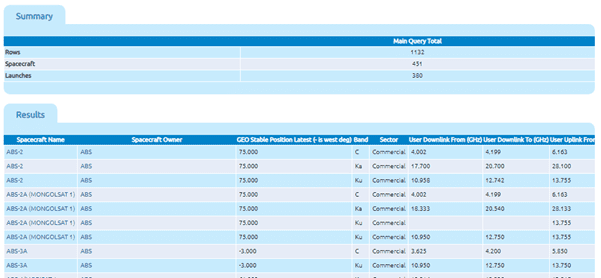For over 40 years, Seradata (and its predecessors) have been tracking and logging satellite and launch information in our Seradata database (formerly SpaceTrak). A key data element which has been developed more recently is satellite frequency data which provides a great resource for satellite spectrum and bandwidth/capacity analysis.
Seradata analysts review each satellite and attach communications payloads to spacecraft in the database. Data includes: –
- Uplink/downlink satellite frequency bands
- Payload hosted for or trade leased to, (note we do not cover downstream users)
- Payload manufacturer
- Number of transponders/ 36MHZ equivalents
- Bandwidth
- For High Throughput Satellites (HTS) number of user beams
- Polarisation
- Gateway frequencies (generally ITU brought into use)
- User frequencies (generally ITU brought into use (BIU))
- ITU Filings (including links to ITU database)
- ITU country (notifying administration) and operating agency
- GEO stable position history and position status
- Satellite health (status)
Using Seradata’s browser-based interface makes analysis of satellite radio frequency spectrum use easy. For example, if you would like to find all active satellites with Ku band capability over Europe a filtered table can be produced in seconds together with transponder numbers and brought into use (BIU) satellite frequencies.
Source: Seradata database, example satellite band and satellite frequency data output
Where possible we calculate satellite total throughput based on the user beams and bandwidth. In this way, an estimate of market capacity can be built up by the Satellite Spectrum Analyst.
Links to satellite status and ITU filings helps the Spectrum Analyst understand the competitive satellite frequency use situation by band and may reveal unused/available capacity.
For more information about satellite insurance data or the Seradata database and how to subscribe, go to seradata.com/product. If you wish to arrange an online demonstration, please contact us by email: info@seradata.com.

